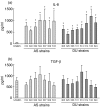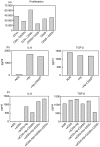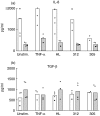Down-regulation of epithelial IL-8 responses in Helicobacter pylori-infected duodenal ulcer patients depends on host factors, rather than bacterial factors
- PMID: 15762883
- PMCID: PMC1809350
- DOI: 10.1111/j.1365-2249.2005.02736.x
Down-regulation of epithelial IL-8 responses in Helicobacter pylori-infected duodenal ulcer patients depends on host factors, rather than bacterial factors
Abstract
Helicobacter pylori infection is one of the most common gastrointestinal infections worldwide. Although the majority of the infected individuals remain asymptomatic carriers of the bacteria, approximately 15% develop peptic ulcers, which are most prevalent in the duodenum. H. pylori induce a vigorous immune response which, however, fails to clear the infection. Instead, the chronic inflammation that arises in the infected gastroduodenal mucosa may be involved in the development of H. pylori-associated peptic ulcers. We have previously shown that duodenal ulcer (DU) patients have a significantly lower epithelial cytokine, e.g. IL-8, response in the duodenum than asymptomatic (AS) carriers. In this study we have further investigated the mechanisms behind this finding, i.e. whether it can be explained by bacterial factors, down-regulation of epithelial cytokine production by regulatory T cells, or an impaired ability of the duodenal epithelium in DU patients to produce cytokines. Gastric AGS, and intestinal T84 epithelial cell lines were stimulated with H. pylori strains isolated from DU patients and AS carriers, respectively. All strains were found to induce comparable cytokine and cytokine receptor expression in epithelial cells. Regulatory T cells (CD4+ CD25(high)), isolated from human peripheral blood and cocultured with H. pylori stimulated AGS cells, were found to slightly suppress H. pylori-induced epithelial cytokine production. Furthermore, primary cultures of duodenal epithelial cells from DU patients were found to produce markedly lower amounts of cytokines than epithelial cells isolated from AS carriers. These results suggest that the lower epithelial cytokine responses in the duodenum of DU patients, which may be of importance for the pathogenesis of H. pylori-induced duodenal ulcers, most likely can be explained by host factors, i.e. mainly a decreased ability of the duodenal epithelium to produce cytokines, but possibly partly also down-regulation by regulatory T cells.
Figures




 ). Cells were stimulated with TNF-α, the patient's homologous, previously collected duodenal strain (HL) and the two H. pylori strains Hel312 and Hel305. Bars represent means and each circle one individual. One AS carrier and one DU patient were eradicated at the time of biopsy sampling. Values from these individuals are shown as filled circles.
). Cells were stimulated with TNF-α, the patient's homologous, previously collected duodenal strain (HL) and the two H. pylori strains Hel312 and Hel305. Bars represent means and each circle one individual. One AS carrier and one DU patient were eradicated at the time of biopsy sampling. Values from these individuals are shown as filled circles.Similar articles
-
FOXP3-expressing CD4(+) T-cell numbers increase in areas of duodenal gastric metaplasia and are associated to CD4(+) T-cell aggregates in the duodenum of Helicobacter pylori-infected duodenal ulcer patients.Helicobacter. 2009 Jun;14(3):192-201. doi: 10.1111/j.1523-5378.2009.00673.x. Helicobacter. 2009. PMID: 19702849
-
Decreased epithelial cytokine responses in the duodenal mucosa of Helicobacter pylori-infected duodenal ulcer patients.Clin Diagn Lab Immunol. 2003 Jan;10(1):116-24. doi: 10.1128/cdli.10.1.116-124.2003. Clin Diagn Lab Immunol. 2003. PMID: 12522049 Free PMC article.
-
Genetic polymorphism of interleukin-8 (IL-8) is associated with Helicobacter pylori-induced duodenal ulcer.Eur Cytokine Netw. 2004 Oct-Dec;15(4):353-8. Eur Cytokine Netw. 2004. PMID: 15627645
-
Immune and inflammatory responses to Helicobacter pylori infection.Scand J Gastroenterol Suppl. 1996;215:3-10. Scand J Gastroenterol Suppl. 1996. PMID: 8722376 Review.
-
Role of Helicobacter pylori in gastritis and duodenitis in man.Agents Actions. 1992;Spec No:C47-9. Agents Actions. 1992. PMID: 1442334 Review.
Cited by
-
CagA EPIYA polymorphisms in Colombian Helicobacter pylori strains and their influence on disease-associated cellular responses.World J Gastrointest Oncol. 2013 Mar 15;5(3):50-9. doi: 10.4251/wjgo.v5.i3.50. World J Gastrointest Oncol. 2013. PMID: 23671731 Free PMC article.
-
Extracellular adenosine generation in the regulation of pro-inflammatory responses and pathogen colonization.Biomolecules. 2015 May 5;5(2):775-92. doi: 10.3390/biom5020775. Biomolecules. 2015. PMID: 25950510 Free PMC article. Review.
-
The effect of age on the gingival crevicular fluid composition during experimental gingivitis. A pilot study.Open Dent J. 2010 Mar 1;4:13-26. doi: 10.2174/1874210601004010013. Open Dent J. 2010. PMID: 20502645 Free PMC article.
-
A2A adenosine receptor (AR) activation inhibits pro-inflammatory cytokine production by human CD4+ helper T cells and regulates Helicobacter-induced gastritis and bacterial persistence.Mucosal Immunol. 2009 May;2(3):232-42. doi: 10.1038/mi.2009.4. Epub 2009 Mar 4. Mucosal Immunol. 2009. PMID: 19262506 Free PMC article.
-
Therapy with omeprazole modulates regulatory T cell/T helper 17 immune response in children with duodenal ulcers.Inflammopharmacology. 2018 Apr;26(2):337-347. doi: 10.1007/s10787-017-0380-x. Epub 2017 Jul 22. Inflammopharmacology. 2018. PMID: 28735449 Clinical Trial.
References
-
- Kuipers EJ, Thijs JC, Festen HP. The prevalence of Helicobacter pylori in peptic ulcer disease. Alimentary Pharmacol Therapeutics. 1995;9(Suppl. 2):59–69. - PubMed
-
- Blaser MJ, Perez-Perez GI, Kleanthous H, et al. Infection with Helicobacter pylori strains possessing cagA is associated with an increased risk of developing adenocarcinoma of the stomach. Cancer Res. 1995;55:2111–5. - PubMed
-
- Hamlet A, Thoreson AC, Nilsson O, et al. Duodenal Helicobacter pylori infection differs in cagA genotype between asymptomatic subjects and patients with duodenal ulcers. Gastroenterology. 1999;116:259–68. - PubMed
-
- Atherton JC, Peek RM, Jr, Tham KT, et al. Clinical and pathological importance of heterogeneity in vacA, the vacuolating cytotoxin gene of Helicobacter pylori. Gastroenterology. 1997;112:92–9. - PubMed
Publication types
MeSH terms
Substances
LinkOut - more resources
Full Text Sources
Medical
Research Materials

